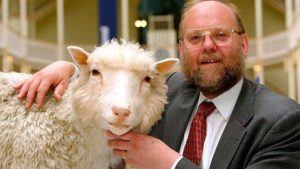
Informative review paper update readers about the state of knowledge on a focused topic or research issue without taking a position. In this informative review, the problem being addressed is on the negative side of planned parenthood affecting the cloning process.
Human Cloning
Concerns on the Ethical Issues of Human cloning.
Dr. Ian Wilmut And Dolly, National Museum of Scotland. Born on July 5, 1996 At the Roslin Institute in Edinburgh, Dolly Died on February 14, 2003 of a Progressive Disease of The Lung, Before Turning 7 Years Old.
Although Cloning has created breakthroughs in the field of medical science, the popular press terms it “freakish.” According to the Copernicus Science Center, the concept of cloning has been around as far as 1938. Hans Spemann proposed an experiment to replace the nucleus of an egg cell with the nucleus of another cell, and then grow an embryo from such an egg. Dolly, the first mammal cloned from a cell taken from an adult animal in 1996, by a method called cloning by fusion (SCNT). Scientists verified that the success, represented the next step into genetic engineering, a progression into using cloned stem cells to produce drugs, and other therapies in the hope of curing deadly diseases such as cancer, but the public feared it to be disastrous.
Cloning is classified into therapeutic and reproductive. Therapeutic cloning involves the use of cloning processes to produce embryonic stem cells for experiments, aimed at creating tissues to replace injured or diseased tissues. Reproductive cloning uses cloning to grow a copy of an animal sharing the same DNA as the progenitor. The idea of using the reproductive cloning process may appear counterproductive to the public.
Although, reproductive cloning enables researchers to make copies of animals with potential benefits in the fields of medicine and agriculture. For instance, the same Scottish researchers who cloned Dolly also cloned other sheep genetically modified to produce milk that contains a human protein essential for blood clotting. However, the hope to one day purify the protein from the milk and make it available for the public is still in development.
This discovery motivated some researchers to successfully clone another Asian ox and three African cats from frozen embryos as a source of DNA. Finally, the use of cloned animals to test new drugs and treatments strategies. Since they are genetically identical, the responses from the drugs should be the same rather than variable as seen in animals with different genetic makeup.
Moreover, there are potential drawbacks to cloning, reproductive cloning is an inefficient technique, and most cloned animals’ embryo cannot develop into healthy individuals. Such is the case of Dolly, the only fetus to survive out of a total of 277 cloned embryos. Researchers have observed some adverse health effects from cloned sheep, and other mammals such as an increase in the average weight of a calf or lambs making parturition hard.
The public is still concerned about the adverse effects of cloning, but the concept of cloning issued several approaches like the use of in-vitro fertilization, that created the first test tube baby, Louise Brown. Public concerns were eased regarding the method of in-vitro fertilization due to the delivery of Louise. The birth of Louise Brown brought hope to couples all over the world, who were at high genetic risk, could then prevent the disease in their offspring before superfetation. Like Randy and Caroline Gold’s child, Eden, who was diagnosed with Mucolipidosis type-4 at the age of 18 months. A genetic disorder that hindered her from talking, walking and shorten her lifespan. A remarkable discovery by Dr. Mark Hughes concerning the use of the cloning process employed pre-implantation genetic diagnosis onto identifying embryos without the genetic disorder for the couples next child, Shai. Planned Parenthood keeping aborted babies alive to harvest their organs for experiments and replacement components, shows an utter lack of ethics and compassion for human life, but this should not justify the belief that cloning is evil.
]Although cloning raises significant ethical issues, drawing from traditional religion and societal values, reproductive and therapeutic cloning have achieved significant advancements that benefit and enhance peoples’ lives. One of which is helpful for infertile couples hoping to fulfill their dream of becoming parents and including children in need of an organ transplant. So, should we base our verdict regarding the use of cloning on uninformed values alone, or should we also consider the overall benefits it provides to humanity?
References
A brief history of cloning. (n.d.). Retrieved September 24, 2018, from http://www.kopernik.org.pl/en/special-projects/archiwum-projektow/projekt-genesis/krotka-historia-klonowania/
The Forefront of Genomics (Ed.). (2017, March 12). Cloning. Retrieved September 24, 2018, from https://www.genome.gov/
Medicine. (1974). Ottawa: Information Canada.



